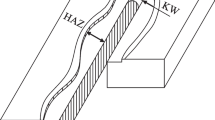Abstract
Welding parameters play a significant role in determining the bead geometry and hence the quality of the weld joint. To further improve prediction accuracy and optimization quality of laser brazing, the published experiment results are utilized to build a prediction model of top and bottom width of weld bead and further establish an optimization model by a novel hybrid extreme learning machine and genetic algorithm method. Firstly, about two-third experiment results are used to train the extreme learning machine network for suitable weights, and then the rest one-third experiments are selected as a test set to illustrate the validity and reliability of the prediction network. Then, by regarding the prediction values from the extreme learning machine as the fitness values of genetic algorithm, optimal results of the inputs and outputs are obtained through the procedure of selection, crossover, and mutation. Eventually, the final optimization results are confirmed by verification experiments. Meanwhile, the hybrid model is more accurate and stable than that using back propagation neural network and genetic algorithm. In the whole, the proposed method in this paper is an effective and accurate way for optimizing laser brazing welding parameters and guiding the actual welding process.
Similar content being viewed by others
Preferences
Benyounis KY, Olabi AG (2008) Optimization of different welding processes using statistical and numerical approaches-A reference guide. Adv Eng Softw 39:483–496
Katherasan D, Elias JV, Sathiya P, Haq AN (2014) Simulation and parameter optimization of flux cored arc welding using artificial neural network and particle swarm optimization algorithm. J Intell Manuf 25:67–76
Juang SC, Tarng YS (2002) Process parameter selection for optimizing the weld pool geometry in the tungsten inert gas welding of stainless steel. J Mater Process Technol 122:33–37
Aloraier A, Almazrouee A, Shehata T, Price JWH (2012) Role of welding parameters using the flux cored arc welding process of low alloy steels on bead geometry and mechanical properties. J Mater Eng Perform 21(4):540–547
Katherasan D, Elias JV, Sathiya P, Haq AN (2013) Modeling and optimization of flux cored arc welding by genetic algorithm and simulated annealing algorithm. Multidiscip Model Mater Struct 9(3):307–326. doi:10.1108/MMMS-03-2012-0008
Palani PK, Murugan N (2006) Development of mathematical models for prediction of weld bead geometry in cladding by flux cored arc welding. Int J Adv Manuf Technol 30:669–676
Dey V, Pratihar DK, Datta GL, Jha MN, Saha TK, Bapat AV (2009) Optimization of bead geometry in electron beam welding using a genetic algorithm. J Mater Process Technol 209:1151–1157
Mondal S, Bandyopadhyay A, Pal PK (2014) Application of artificial neural network for the prediction of laser cladding process characteristics at Taguchi-based optimized condition. Int J Adv Manuf Technol 70:2151–2158
Kim J, Kim I, Kim Y (2014) Optimization of weld pitch on overlay welding using mathematical method. Int J Precis Eng Manuf 15(6):1117–1124
Shi H, Zhang K, Xu Z, Huang T, Fan L, Bao W (2014) Applying statistical models optimize the process of multi-pass narrow-gap laser welding with filler wire. Int J Adv Manuf Technol 75(1):279–291
Saida K, Ohnishi H, Nishimoto K (2010) Fluxless laser brazing of aluminum alloy to galvanized steel using a tandem beam-dissimilar laser brazing of aluminum alloy and steels. Weld Int 24(3):161–168
Lu F, Lu B, Tang X, Yao S (2008) Study of influencing factors and joint performance of laser brazing on zinc-coated steel plate. Int J Adv Manuf Technol 37:961–965
Song Z, Nakata K, Wu A, Liao J (2013) Interfacial microstructure and mechanical property of Ti6Al4V/A6061 dissimilar joint by direct laser brazing without filler metal and groove. Mater Sci Eng A-Struct Mater Prop Microstruct Process 560:111–120
Peyre P, Berthe L, Dal M, Pouzet S, Sallamand P, Tomashchuk I (2014) Generation and characterization of T40/A5754 interfaces with lasers. J Mater Process Technol 214:1946–1953
Lee PY, Sun ZC, Liao M, Han SL, Hou BB, Zhang B (2014) The study of crack mechanism during arc brazing of cooling pipe to ITER magnet support system. IEEE Trans Appl Supercon 24(3). doi: 10.1109/TASC.2013.2291071
Klock F, Frank S (2013) Surface deposits in laser brazing. Sci Technol Weld Join 18(1):62–69
Iordachescu D, Quintino L, Miranda R, Pimenta G (2006) Influence of shielding gases and process parameters on metal transfer and bead shape in MIG brazed joints of the thin zinc coated steel plates. Mater Des 27:381–390
Rong YM, Zhang Z, Zhang GJ, Yue C, Gu YF, Huang Y, Wang CM, Shao XY (2015) Parameters optimization of laser brazing in crimping butt using Taguchi and BPNN-GA. Opt Lasers Eng 67:94–104
Wang B, Hua L, Wang X, Song Y, Liu Y (2015) Effects of electrode tip morphology on resistance spot welding quality of DP590 dual-phase steel. Int J Adv Manuf Technol. doi:10.1007/s00170-015-7703-0
Huang GB, Zhu QT, Siew CK (2006) Extreme learning machine: theory and applications. Neurocomputing 70:489–501
Huang GB, Zhou H, Ding X, Zhang R (2012) Extreme learning machine for regression and multiclass classification. IEEE Trans Syst Man Cybern B Cybern 42(2):513–529
Huang GB, Wang DH, Lan Y (2011) Extreme learning machines: a survey. Int J Mach Learn Cyber 2:107–122
Canyurt OE, Kim HR, Lee KY (2008) Estimation of laser hybrid welded joint strength by using genetic algorithm approach. Mech Mater 40:825–831
Chen C, Chen P, Chiang W (2012) Modified intelligent genetic algorithm-based adaptive neural network control for uncertain structural systems. J Vib Control 19:1333–1347
Author information
Authors and Affiliations
Corresponding author
Rights and permissions
About this article
Cite this article
Rong, Y., Zhang, G., Chang, Y. et al. Integrated optimization model of laser brazing by extreme learning machine and genetic algorithm. Int J Adv Manuf Technol 87, 2943–2950 (2016). https://doi.org/10.1007/s00170-016-8649-6
Received:
Accepted:
Published:
Issue Date:
DOI: https://doi.org/10.1007/s00170-016-8649-6




